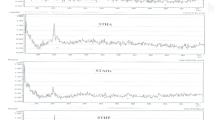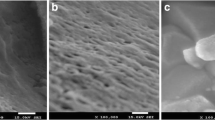Abstract
The sorptive and desorptive behavior of 1,2,4-Trichlorobenzene (TCB) was studied in a mixture of river sediments and TCB at initial aqueous concentrations of 0.5, 4, and 21 mg/L. All experiments were performed at a temperature of 20∘C and at pH 5.58. Grain size, fraction of organic carbon (FOC), and pH analyses were conducted to determine the initial condition of the sediment. Adsorption experiments reached equilibrium 8 hours after the start of the experiment. Adsorption data were used to calculate the monolayer sorption capacity (Q), the Langmuir entropy constant (b), the Freundlich adsorption coefficients (Kd, Kd′), and the Freundlich characteristic constant (n) as well as R-square values. Desorption experiments utilized a 4 g/L persulfate solution added to soils “pre-contaminated” with TCB during the adsorption experiments. Studies indicated that persulfate was an effective oxidizer of both sediment organic matter and TCB. After a contact time of 5 hours, the mass of sediment organic carbon was reduced from 4.45% to 0.44%. The TCB released to solution with organic matter oxidation was then oxidized to non-detectable levels by persulfate and the possible presence of free radicals. The conclusions were made that persulfate has the potential to be an effective oxidizer of both TCB and sediment organic matter.
Similar content being viewed by others
References
American Society of Testing and Materials. 1991. Standard Method for Particle-Size Analysis of Soils, Designation: D 422-63, Annual Book of ASTM Standards, Sec. 4, Vol. 04.08, Philadelphia, PA.
Chen, W., Kan, A. T. and Tomson, M. B.: 2000. ‘Irreversible adsorption of chlorinated benzenes to natural sediments: implications for sediment quality criteria’, Environ. Sci. Technol. 34, 385.
Chiou, C. T., Peters, L. J. and Freed, V. H.: 1979. ‘A physical concept of soil-water equilibria for nonionic organic compounds’, Science 206, 831.
DiVincenzo, J. and Dentel, K.: 1996. Sorption-desorption of 1,2,4-trichlorobenzene on soil: anionic surfactant and cationic polyelectrolyte effects,J. of Environ. Qual. 25, 1193.
Indelli, A., Bartocci, V., Ferranti, F. and Lucarelli, M.: 1966. ‘Salt effects in the reaction of peroxydisulfate with thiosulfate’, J. Chem. Phys. 44, 2069.
Johnson, M. D. and Weber, W. J., Jr.: 2001. ‘Rapid Prediction of Long-Term Rates of Contaminant Desorption from Soils and Sediments’, Environ. Sci. Technol. 35, 427.
Lee, D. Y., Farmer, W. J. and Aochi, Y.: 1990. ‘Sorption of Napropamide on Clay and Soil in the Presence of Dissolved Organic Matter’. J. Environ. Qual. 19, 567.
Nadim, F., Huang, K. C. and Dahmani, A. M.: 2004. ‘Remediation of Soil and Ground Water Contaminated with PAH using Heat and Fe(II)-EDTA Catalyzed Persulfate Oxidation’, in Bagtzoglou, A. C. and Nadim, F. (eds), Proc. Mid-Atlantic Industrial and Hazardous Waste, the 36th Conference held at the University of Connecticut, Storrs, Connecticut, (Oct 8–10), pp 178–181.
Nadim, F., Huang, K. C. and Dahmani, A. M.: 2005. ‘Remediation of Soil and Ground Water Contaminated with PAH using Heat and Fe(II)-EDTA catalyzed persulfate oxidation’, Manuscript submitted for publication inJ. of Water, Air and Soil Pollution.
Najm, I., Marcinko, J. and Oppenheimer, J.: 2000. Evaluating TOC analytical results.J. AWWA 92, 84.
Soil and Plant Analysis Council, Inc. 1999.Soil Analysis: Handbook of Reference Methods, New York: CRC Press.
Schwarzenbach, R. P., Gschwend, P. M. and Imboden, D. M.: 1993.Environmental Organic Chemistry, New York: John Wiley & Sons, Inc.
Tan, K. H.: 1994.Environmental Soil Science, New York: Marcel Dekker, Inc.
U.S. Department of Health and Human Services: 1993.Hazardous Substances Data Bank (HSDB, online database). National Toxicology Information Program, National Library of Medicine, Bethesda, MD.
USEPA (U. S. Environmental Protection Agency). 1996. Test Methods for Evaluating Solid Waste,Method 8260B, for Volatile Organic Compounds by Gas Chromatography/Mass Spectrometry (GC/MSD). SW-846, 3rd Edition.
USEPA (U. S. Environmental Protection Agency): 1998.Contaminated Sediment Management Strategy.Washington, DC 20460. EPA-823-R-97-001.
Voice, T. C. and Weber Jr., W. J.: 1983. ‘Sorption of hydrophobic compounds by sediments, soils and suspended solids-I’, Water Res. 17, 1433.
Weber, W. J., Jr.: 1972.Physiochemical Processes for Water Quality Control, New York: Wiley-Interscience.
Author information
Authors and Affiliations
Corresponding author
Rights and permissions
About this article
Cite this article
Barbash, A.M., Hoag, G.E. & Nadim, F. Oxidation and Removal of 1,2,4-Trichlorobenzene using Sodium Persulfate in a Sorption-Desorption Experiment. Water Air Soil Pollut 172, 67–80 (2006). https://doi.org/10.1007/s11270-005-9052-3
Received:
Accepted:
Published:
Issue Date:
DOI: https://doi.org/10.1007/s11270-005-9052-3




